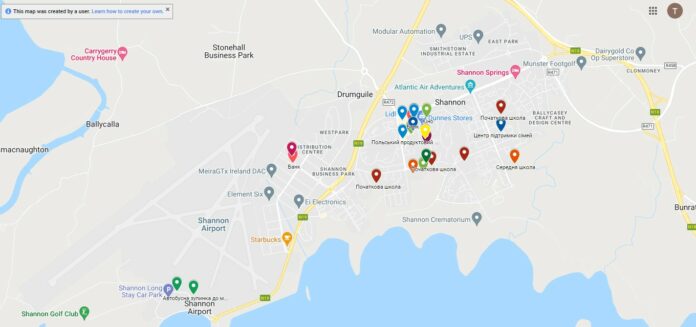A BESPOKE video and series of interactive maps that introduce newly arrived Ukrainian people to vital county services has been developed by the Clare Children and Young People’s Services Committee (CYPSC).
The project, led by Tusla staff member Sinead Collopy, coordinator with the CYPSC in Clare, is an information and signposting initiative delivered in the Ukrainian language.
Identifying gaps in service provision and signposting is one of the Clare CYPSC’s key strategic aims. Together with other CYPSC partner agencies, the initiative gathered momentum as numbers of Ukrainians arriving in the county increased rapidly.
The Clare Ukrainian support video introduces Ukrainians to the county, simply explaining where the main towns and cities are and what facilities are available, from transport links to educational services. The video also describes what the principal industries are, from farming and tourism to manufacturing parks and industrial estates.
There are four maps to cover areas in Clare – Ennis; Shannon; Kilkee village and Kilrush town in West Clare, and Ennistymon and Lisdoonvarna in North Clare. These are accessible on links that appear at the end of a demonstration video.
The maps all have useful pins that point to essential services for newly arrived Ukrainians – all in their mother tongue.
Clare has more than 2,000 Ukrainian arrivals, children and adults, over recent weeks, so Clare CYPSC had to be very creative in how best to support all those people.
Advice and guidance were provided to the CYPSC by Dr Brendan Halpin, head of the Geography Department at the University of Limerick, who advised on how to put the maps together.
Using the edit function on Google Maps, pins can be inserted on vital services. The Department of Education’s list of schools in the county was then input, using unique Eircodes. Each pin is clickable, with a link to the school website.
The pins on the map are colour-coded and linked to a legend… a yellow pin for a post office, a red pin is an education service, and so on.
Google Translate was used to help users understand what each service was. Everything from parks and health centres to shops and police stations are listed on the maps.
The video and maps were narrated by Ukrainian volunteer Olean Domina, a marketing professional who fled her home in Kiev and came to Ireland in March with her three children. Funding was provided through Clare CYPSC from the Department of Children, Equality, Disability, Integration and Youth’s Ukraine-CYPSC Support Fund.
It is hoped that the resource will provide instant, practical signposting support for refugees arriving in the county.
“It’s very comforting for people to be able to hear their own language when they arrive. The video gives them a grounding and shows them how to navigate in a place during what is a very stressful situation for them,” says Sinead.
According to the CYPSC Coordinator, the reaction so far to the online support, which is available through WhatsApp, has been “hugely positive”.
“The aim is to circulate the video and maps to as many Ukrainian people in the county as possible via What’s App groups that have been established for hotel residents,” adds Sinead. “To date, it has been WhatsApp’ed to over 1,000 people.
The app was deemed the best route to take as the Ukrainians arriving here are using it to pass on information to each other. Now, they can forward this invaluable support, too.
You can check out the video here on the Clare CYPSC website https://www.cypsc.ie/local-resources/clare-cypsc-ukraine-response.3489.html. Links to the maps are also available on the site.


